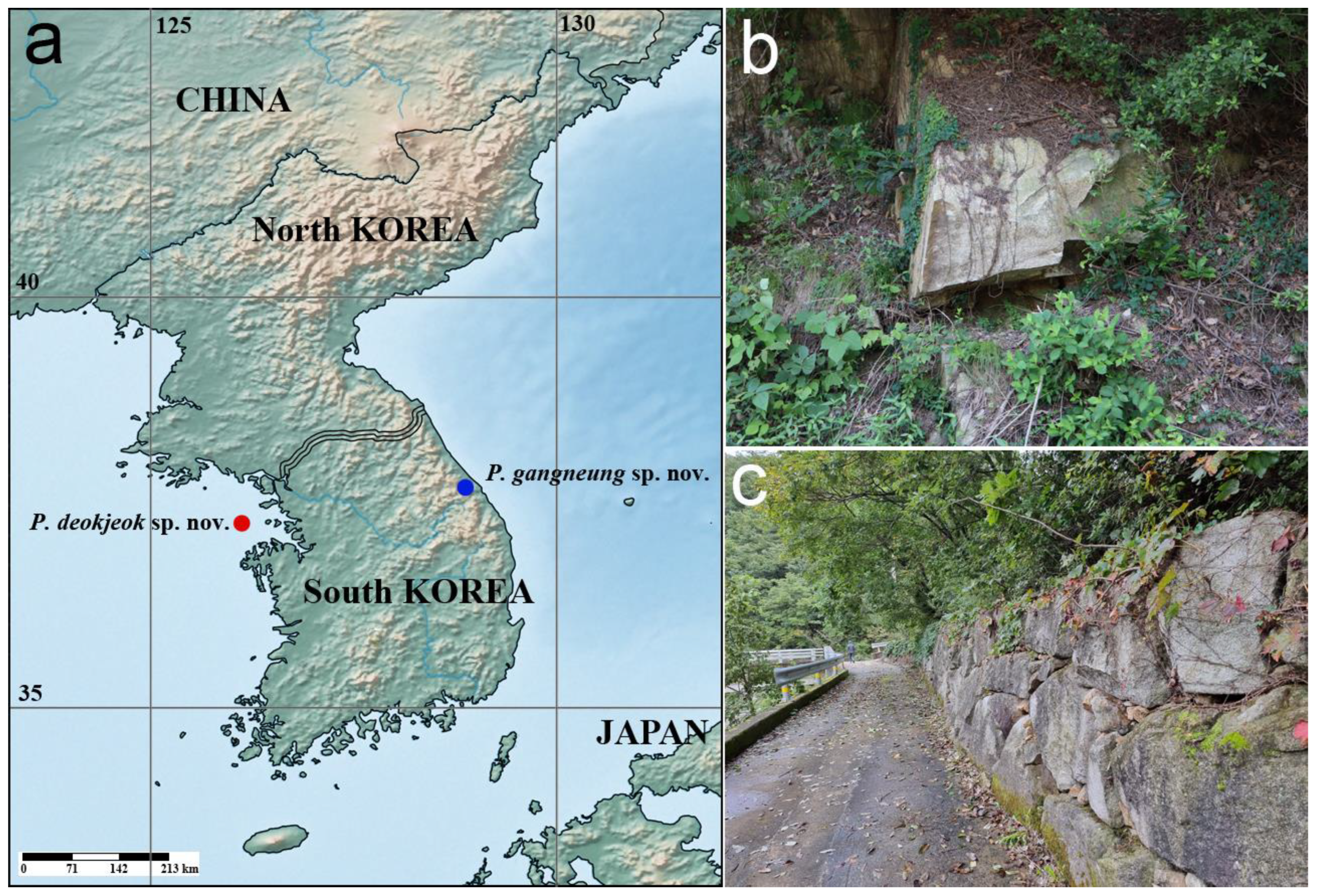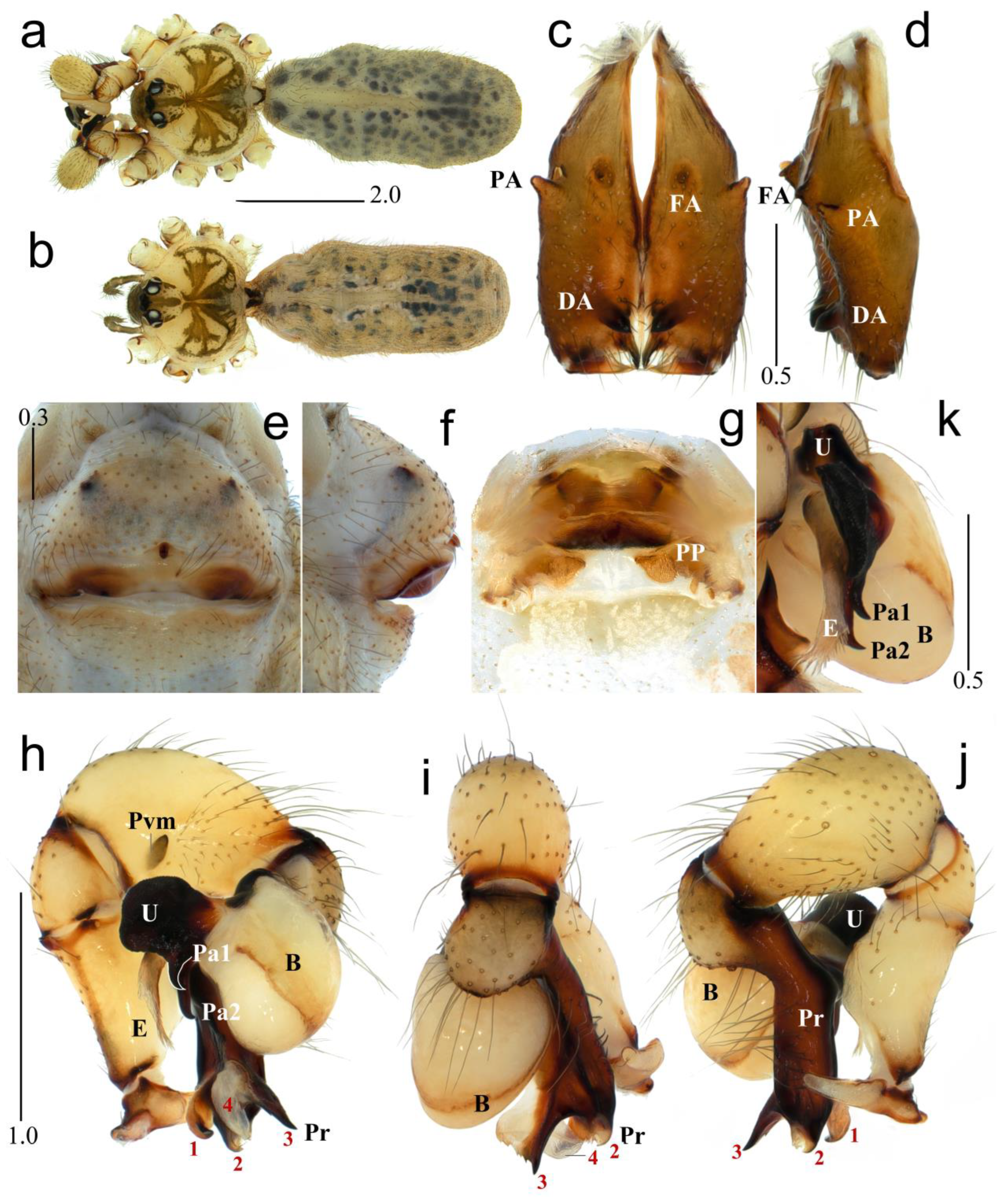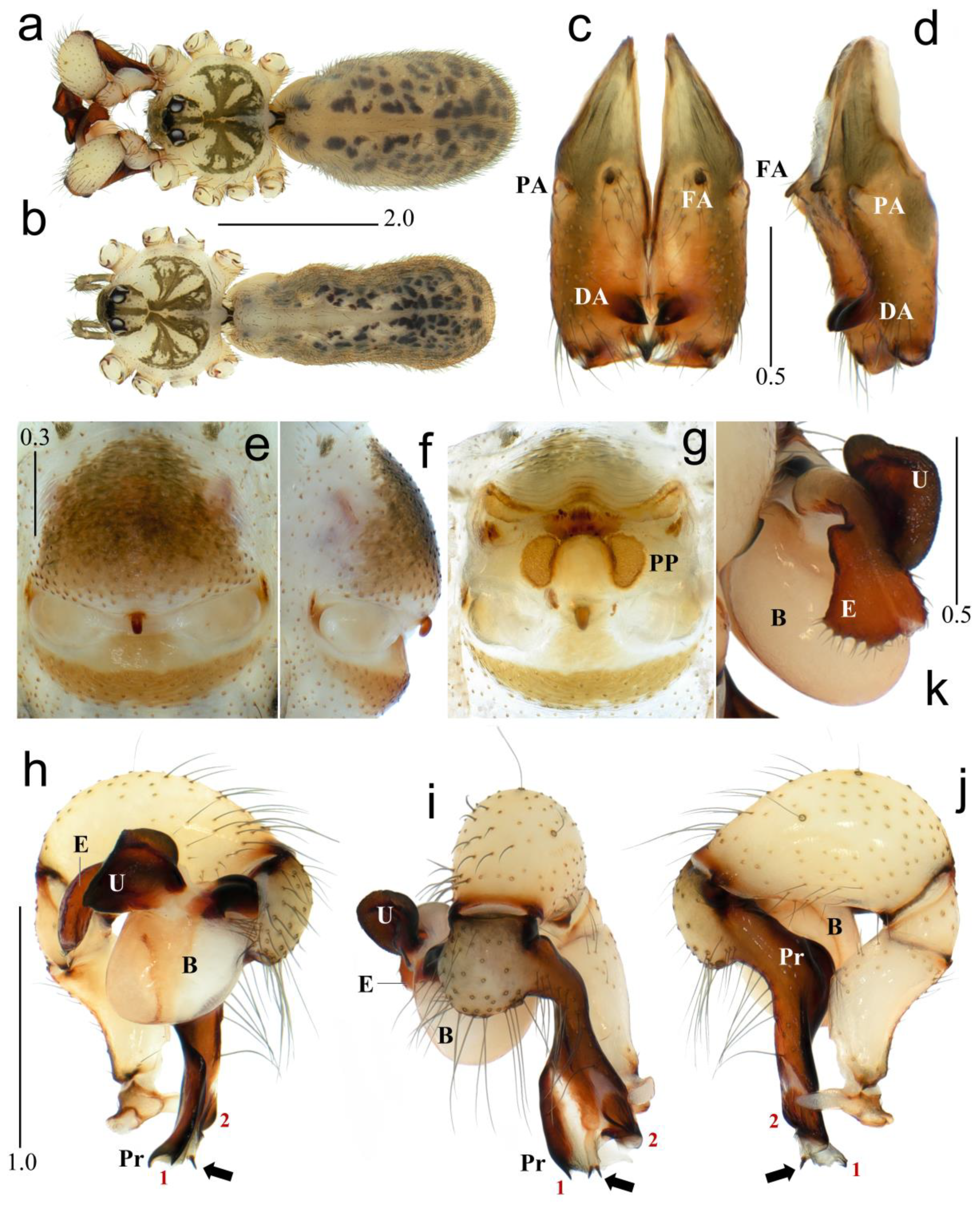3.1. Pholcus deokjeok sp. nov.
Type material. Holotype: ♂, Bijobong Peak, Deokjeokdo Island, Jin-ri, Deokjeok-myeon, Ongjin-gun, Incheon-si, South Korea (37.214236N, 126.124386E, alt. 65 m), 26 July 2022, C.M. Jang leg. (NIBR, #WGJTIV0000000568). Paratypes: 6♀♀, same data as the holotype (KKU, #Ara_Phol_Deokjeok_202201~06_PT).
Etymology. The specific name is a noun in apposition and refers to the type locality, Deokjeokdo Island.
Diagnosis. The new species is similar to
Pholcus chiakensis Seo, 2014 in the shape of the palpal organ and body appearance but can be easily distinguished from the latter by the combination of the following characters: Male—uncus with two short and long hook-shaped pseudoappendices (
Figure 2h,k); procursus with four distal apophyses (two thick ventral and retrolateral apophyses with hooked tips numbered 1 and 2 in
Figure 2h–j; one spear-shaped and broad dorsal apophysis with appointed numbered 3 in
Figure 2h–j; one thick, finger-shaped, and membranous prolateral apophysis with a pointed tip numbered 4 in
Figure 2h,i) versus uncus with two slender and knife-shaped, and pointed short pseudoappendices; procursus with four distal apophyses (one small pointed ventral apophysis; one retrolateral apophysis with a hooked tip; one spear-shaped and broad dorsal apophysis with a twisted tip; and one thick, irregular-shaped, and membranous prolateral apophysis with a blunt tip) in
P. chiakensis (
Figure 2A–C) [
15]. Female—a pair of semicircle-shaped pore plates and projected inward in the internal genitalia (
Figure 2e–g) versus a pair of European pear-shaped pore plates in the internal genitalia in
P. chiakensis (
Figure 2G,H) [
15].
Description. Male (holotype). Habitus as in
Figure 2a. Total length 5.56. Carapace: 1.84 long/1.95 wide. Eyes: AER 0.70, PER 0.74, ALE 0.18, AME 0.11, PLE 0.18, PME 0.16, ALE–PLE contiguous, AME–ALE 0.06, AME–AME 0.08, AME–PME 0.05, PME–PLE 0.04, PME–PME 0.30. Chelicera: 1.18 long/0.34 wide. Endite: 0.58 long/0.35 wide. Labium: 0.30 long/0.39 wide. Sternum: 0.90 long/1.19 wide. Legs: I 48.15 (12.19, 0.71, 12.62, 20.27, 2.36)/II 31.78 (8.96, 0.68, 8.02, 12.64, 1.48)/III 22.51 (6.46, 0.68, 5.55, 8.54, 1.28)/IV 28.19 (8.16, 0.64, 7.16, 11.04, 1.19), tibia I L/d 83. Palp: 3.71 (0.78, 0.41, 1.15, -, 1.37). Abdomen: 3.72 long/1.68 wide.
Carapace pale yellowish brown, cephalic region with pale blackish brown median and marginal bands, thoracic region with pale blackish brown radial and marginal bands (
Figure 2a). Chelicera with three apophyses; blunt proximo-lateral apophysis diagonally upward and protrudent out of chelicera, small and pointed frontal apophysis protrudent forward, and thick and pointed distal apophysis diagonally downward (
Figure 2c,d). Legs yellowish brown, retrolateral trichobothrium on tibia I at 4% proximally, tarsus I with >40 pseudosegments (only distally about 10 visible), 3/4 of femora brown or pale blackish brown proximally with one brown distal annulus, tibia I with one brown annulus at proximal end and two distal annuli, tibiae II–IV with two brown proximal annuli and two distal annuli, metatarsi with one brown annulus at proximal end, leg formula I–II–IV–III. Abdomen elliptical, pale greenish yellow with a long cardiac pattern and many black irregular spots (
Figure 2a). Palp (
Figure 2h–k): trochanter with blunt and bulged retrolatero-ventral apophysis, shorter than femur; palpal tibia with finger-shaped prolatero-ventral modification (
Figure 2h); bulb pale yellowish brown, cordiform, appendix absent (
Figure 2h); uncus dark blackish brown and fist-shaped with fine scales, edge finely serrated, two hook-shaped pseudoappendices present, pseudoappendix 1 shorter than pseudoappendix 2 (
Figure 2h,k); embolus unmodified, weakly sclerotized with some semi-transparent distal fringed processes (
Figure 2h,k); procursus large and brown with dark blackish brown margin, distinct ventral knee present, four distal apophyses present, two thick ventral and retrolateral apophyses with hooked tips (numbered 1, 2 in
Figure 2h–j); one spear-shaped (in lateral view) and broad (in frontal view) dorsal apophysis partly sclerotized and membranous with many distal processes (numbered 3 in
Figure 2h–j); one thick, finger-shaped, and membranous prolateral apophysis with a pointed tip (numbered 4 in
Figure 2h,i); dorsal spine absent.
Female. General appearance similar to male, habitus as in
Figure 2b. Total length 4.92. Carapace: 1.63 long/1.88 wide. Eyes: AER 0.64, PER 0.70, ALE 0.17, AME 0.12, PLE 0.18, PME 0.15, ALE–PLE contiguous, AME–ALE 0.07, AME–AME 0.05, AME–PME 0.06, PME–PLE 0.06, PME–PME 0.23. Chelicera: 1.01 long/0.32 wide. Endite: 0.55 long/0.29 wide. Labium: 0.24 long/0.37 wide. Sternum: 0.87 long/1.14 wide. Legs: I 35.25 (8.88, 0.69, 8.98, 14.54, 2.16)/II 28.35 (8.04, 0.63, 7.15, 11.24, 1.29)/III 17.31 (5.02, 0.57, 4.24, 6.54, 0.94)/IV 24.08 (7.01, 0.58, 6.05, 9.25, 1.19), tibia I L/d 60. Palp: 1.17 (0.38, 0.17, 0.21, -, 0.41). Abdomen: 3.29 long/1.58 wide. Epigynum: 1.14 wide.
Legs yellowish brown, femora with two pale brown proximal annuli and two brown distal annuli, tibiae with two brown proximal annuli and two brown distal annuli, metatarsi with one brown annulus at proximal end, leg formula I–II–IV–III. Epigynum (
Figure 2e,f): sclerotized, anterior epigynal plate strongly protrudent, anterior arch with median portion almost straight; small and short knob with a blunt tip. Internal genitalia (
Figure 2g): anterior arch straight with a pair of semicircle-shaped pore plates and projected inward.
Habitat. The species was collected by hand on rock walls and under rocks in a hilly mixed forest (
Figure 1b).
Distribution. South Korea (Deokjeokdo Island, Incheon-si) (
Figure 1a).
3.2. Pholcus gangneung sp. nov.
Type material. Holotype: ♂, Mt. Jabyeongsan, Sangye-ri, Okgye-myeon, Gangneung-si, Gangwon-do, South Korea (37.573733N, 128.961348E, alt. 119 m), 19 September 2022, C.M. Jang & S.T. Kim leg. (NIBR, #NIBRIV0000901598). Paratypes: 11♀♀ 4♂♂, same data as the holotype (KKU, #Ara_Phol_Gangneung_202201~15_PT).
Etymology. The specific name is a noun in apposition and refers to the type locality, Gangneung-si.
Diagnosis. This species can be distinguished from the other
Pholcus phungiformes group members by the combination of the following characters: Male—embolus highly modified, sclerotized with 16–17 distal spiny process (
Figure 3h,k); procursus with two simple distal apophyses present (one bifurcate and broad prolatero-ventral apophysis with pointed corners numbered 1 in
Figure 3h–j, one round retrolateral apophysis numbered 2 in
Figure 3h–j); two ventral spines present at the distal end (arrowed in
Figure 3h–j). Female—epigynal anterior arch with median portion procurved, a small knob with a blunt tip curved downward; anterior arch chevron-shaped with a pair of kidney-shaped pore plates in the internal genitalia (
Figure 3e–g). The unusual shaped and strongly sclerotized embolus of
P. gangneung sp. nov. in the
Pholcus phungiformes group is the first to be reported.
Description. Male (holotype). Habitus as in
Figure 3a. Total length 4.49. Carapace: 1.54 long/1.62 wide. Eyes: AER 0.71, PER 0.77, ALE 0.18, AME 0.15, PLE 0.19, PME 0.18, ALE–PLE contiguous, AME–ALE 0.05, AME–AME 0.07, AME–PME 0.05, PME–PLE 0.05, PME–PME 0.29. Chelicera: 1.05 long/0.30 wide. Endite: 0.47 long/0.29 wide. Labium: 0.28 long/0.37 wide. Sternum: 0.84 long/1.11 wide. Legs: I 37.78 (9.71, 0.61, 9.75, 15.57, 2.14)/II 28.45 (7.32, 0.67, 6.63, 12.50, 1.33)/III 19.72 (5.36, 0.54, 4.54, 8.22, 1.06)/IV 25.55 (6.66, 0.60, 6.01, 11.02, 1.26), tibia I L/d 66. Palp: 3.39 (0.66, 0.38, 1.01, -, 1.34). Abdomen: 2.95 long/1.71 wide.
Carapace pale yellowish brown, cephalic region with pale blackish brown median and marginal bands, thoracic region with pale blackish brown radial and marginal bands (
Figure 3a). Chelicera with three apophyses; blunt proximo-lateral apophysis diagonally upward and unprotrudent out of chelicera, small and pointed frontal apophysis protrudent forward, and thick and pointed distal apophysis slightly diagonally downward (
Figure 3c,d). Legs pale yellowish brown, retrolateral trichobothrium on tibia I at 4% proximally, tarsus I with >35 pseudosegments (only distally about 10 visible), femora with two faint proximal annuli and two blackish brown distal annuli, tibia I with one blackish brown proximal annulus and one distal annulus, tibiae II–IV with two blackish brown proximal annuli and two distal annuli, metatarsi with one blackish brown annulus at proximal end, leg formula I–II–IV–III. Abdomen elliptical, pale yellowish red with a long cardiac pattern and many black irregular spots (
Figure 3a). Palp (
Figure 3h–k): trochanter with blunt and finger-like retrolatero-ventral apophysis, shorter than femur; palpal tibia with finger-shaped prolatero-ventral modification hidden by uncus; bulb pale yellowish brown, pocket-shaped, appendix absent (
Figure 3h); uncus dark blackish brown and fist-shaped with a truncated edge and fine scales, edge finely serrated, pseudoappendix absent; embolus strongly modified, brown, thick, sclerotized, and elongated elliptical in prolateral view, broad spatula-shaped with 16–17 spiny processes distally such as a cactus in frontal view (
Figure 3h,k); procursus large, simple, and brown with dark blackish brown margin, distinct ventral knee present, two distal apophyses present, one bifurcate (in lateral view) and broad (in frontal view) prolatero-ventral apophysis partly sclerotized and membranous with pointed corners (numbered 1 in
Figure 3h–j), one round retrolateral apophysis (numbered 2 in
Figure 3h–j); dorsal spine absent; two ventral spines present at distal end (arrowed in
Figure 3h–j).
Female. General appearance similar to male, habitus as in
Figure 3b. Total length 4.89. Carapace: 1.57 long/1.72 wide. Eyes: AER 0.59, PER 0.66, ALE 0.17, AME 0.11, PLE 0.15, PME 0.16, ALE–PLE contiguous, AME–ALE 0.03, AME–AME 0.06, AME–PME 0.04, PME–PLE 0.06, PME–PME 0.22. Chelicera: 0.94 long/0.31 wide. Endite: 0.47 long/0.28 wide. Labium: 0.26 long/0.34 wide. Sternum: 0.78 long/1.04 wide. Legs: I 33.62 (8.47, 0.66, 8.48, 13.84, 2.17)/II 23.06 (6.24, 0.65, 5.75, 9.04, 1.38)/III 16.56 (4.71, 0.60, 3.98, 6.20, 1.07)/IV 22.3 (6.35, 0.60, 5.40, 8.58, 1.37), tibia I L/d 57. Palp: 1.39 (0.39, 0.17, 0.26, -, 0.45). Abdomen: 3.32 long/1.44 wide. Epigynum: 1.12 wide.
Legs yellowish brown, femora with two pale brown proximal annuli and two blackish brown distal annuli, tibiae with two brown proximal annuli and two brown distal annuli, metatarsi with a blackish brown annulus at the proximal end, leg formula I–II–IV–III. Epigynum (
Figure 3e,f): anterior epigynal plate slightly protrudent, anterior arch with median portion procurved; a small knob with a blunt tip curved downward. Internal genitalia (
Figure 3g): sclerotized, anterior arch chevron-shaped with a pair of kidney-shaped pore plates.
Habitat. The species was collected by hand on artificially constructed rock walls in a mountainous mixed forest (
Figure 1c).
Distribution. South Korea (Gangneung-si, Gangwon-do) (
Figure 1a).







